 |
| The Independent Traveler's Newsletter PAGE TWO |
 |
| The Independent Traveler's Newsletter PAGE TWO |
| ICI ET LÀ |
|
in France or France-related events taking place in the United States & elsewhere between now and the publication of our next issue. In France. . . o The sixth annual PARIS DESIGN WEEK, scheduled to overlap with MAISON & OBJET PARIS, will take place from Saturday, September 3 to Saturday, September 10, 2016. For eight days, the event invites French and international professionals and the general public to discover the best showcases of design in Paris. PARIS DESIGN WEEK is an itinerary uniting 300 participants who proudly promote first-rate design in Paris. At a time when new collections are popping up in stores and the new concepts for the autumn season are being launched, the event brings together the talents and forces of retailers, galleries, showrooms, hotels and restaurants for eight days to share their experience in design and creation with the public. Footpath #1 Now! le Off at Les Docks – Cité de la Mode et du Design. Over a hundred young designers have been selected to show their work as part of the exhibition and to compete for the Rado Star Prize France. Alongside them, a number of emerging design brands will also be launching their concepts on the design market. For this new generation of entrepreneurs, hailing from 25 countries worldwide, now! le Off is a great platform to engage with the media and build a professional network, as well as a place to exchange ideas. The Talks, led by Chantal Hamaide, Editorial Director of French design magazine Intramuros, will be contributing to the bustle of ideas and the diversity of influences so characteristic of Paris Design Week’s headline event. Footpath #2 People just looking up anywhere in the city will be be inspired. In the area of Saint-Germain-desPrés. Between Les Halles, Le Marais and Bastille. Around Opéra, La Concorde and Place de l’Étoile. Over in Stalingrad and Barbès. The new banners of Paris Design Week mark the way for an intuitive stroll along the pathways of French and international creativity in Paris. For more information on PARIS DESIGN WEEK, click here [Press Release Atout France]o Le Mont St-Michel is once again restored to its original island status. Going back farther into history, the 1, 050 year-old Mont St-Michel Abbey in Normandy has been restored to a true island at the highest tides. A major ten-year project with national and ecological importance tackled the problems of rising sand levels which posed a threat to the monument. This new and improved water flow safeguards Le Mont St-Michel bay, protecting its ecosystem and maritime significance. The Tour de France began this year on July 2 from Mont St-Michel as a tribute to mark the occasion. This is a perfect year to explore Normandy's Medieval heritage ~ it was in 1066, the year William the Conqueror became England's first Norman king after his victory at the Battle of Hastings. Visit the Bayeux Museum, also an important D-day site, where the 229-foot long 11th century Tapestry of Bayeux can be admired depicting the Norman conquest of England. o Not only was France the first country to ratify the Paris Climate Accord, but as of July 1, 2016, the city of Paris will levy a fine and ban cars being driven in central Paris that were registered prior to 1997. This is aimed at curbing the city's chronic smog and traffic problems. The ban on cars over 19 years old will affect about 10 percent of vehicles in the city. Paris Mayor Anne Hidalgo has implemented several other measures to reduce smog across the capital including a recent ban of cars from the Champs-Élysées the first Sunday of every month. In addition, the Socialist mayor wants to create more pedestrian zones at major traffic circles and by the River Seine. The city held a 'day without cars' last year, and it will be expanded to cover more neighborhoods this year. 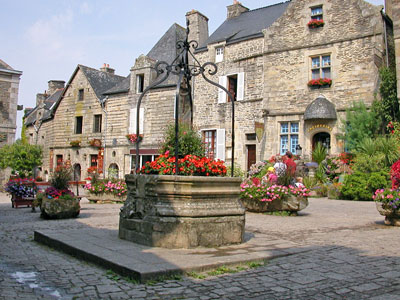 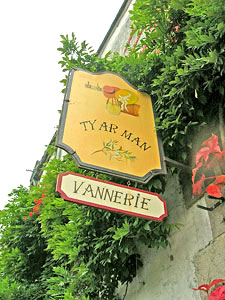 o If you've ever been to Rochefort-en-Terre in Brittany, you will understand why it was recently chosen as France's Plus Beau Village, the second Breton winner for two consecutive years. Thirteen villages competed, and 175,000 votes were cast. This honor will encourage an increase in tourism, perhaps as much as 40%, as well as bringing even more prestige to this special village. The sign in this photo marks the location of a basket maker's shop and is only one example of the dozens of beautiful shop signs in Rochefort-en-Terre, a town of about 700 permanent inhabitants. The pedestrian area in the photo on the right makes Rochefort the perfect place for leisurely strolls to admire buildings dating back as far as the 16th century and to enjoy the proliferation of delightful flowers found everywhere. Of course, Rochefort-en-Terre is among the hundred and a half members of the prestigious association Les Plus Beaux Villages de France. o Baroque Pearls is the title of music festival held in the small commune of Lanvellec, Brittany, for two weeks in October. This two-week long event features Baroque music centered around the unique organ at the parish church of Saint-Brandan. The organ was built by Robert Dalam, organ builder to the English court, who escaped the civil war in 1642 to live in Brittany. The organ was restored in 1986 by Italian Bartholomew Formentelli. Festival from October 14 -30. For further information visit www.festival-lanvellec.fr. o Don't miss Europe's largest flea market, Le Grande Braderie de Lille on the 3 and 4 of September. Perhaps best of all is that this is home to the traditional dish of moules frites ~ there will be 530 tons of it! for details visit www.braderie-de-lille.fr. o Nantes will finally get its international airport after 30 years of debates and squabbling since it was first proposed, although environmentalists are still opposed to its location on protected swampland. A ballot resolution passed at the end of June to build Aéroport du Grande Ouest to replace the existing Nantes Atlantique airport. The cost is estimated at 580 million euros with a capacity of 9 million passengers by 2050, 6 million more than the current facility. They hope it will become the major international gateway to western France. o Annecy, a lovely place with an equally lovely lake, is a busy place this season. From the end of September to the 2nd of October all things related to skiing will be featured in exhibits of products, movie premieres, meeting famous skiers, and more. See www.pyroconcert.com. From September 12 to 18 is the Coup de Théâtre Festival where the audience pays what they want to attend théâtre productions by professional actors. Details at www.agitateursdereves.org. For sports enthusiasts, if the Olympics didn't provide enough, the Red Buill Elements features 70 teams competing in a quadrathon of rowing, trail running, paragliding and mountain biking across a very difficult 50km route. This is a one-day event on September 16. See www.redbull.com/elements. Finally, on October 8th, the 43rd annual celebration of the flocks returning from their summer pastures features arts and crafts, folklore groups and traditional food. Visit annecytraditions.free.fr. o France launched its 'terror' app on June 18th. The SAIP (Système d'Alerte et d'Informations des Populations) is free, in French and English, and available from Google Play and iTunes. It sends warning and alerts to those who agree to be 'geolocated' for floods, major events or crises. In Spain . . . o The 29th Annual World Cheese Awards began accepting entries on Wednesday August 17 with organizers, the Guild of Fine Food, expecting more cheesemakers than ever to enter as the competition heads to San Sebastián, Spain this year, during the city’s tenure as European Capital of Culture. With the World Cheese Awards at its heart, the International Cheese Festival will be held at the Kursaal Congress Centre on San Sebastián’s spectacular beachfront. Dedicated only to cheese, with no other dairy products able to enter, the World Cheese Awards, supported by Artzai Gazta and the Basque Country Government, will be the showpiece event at the inaugural International Cheese Festival. Held between 16-18 November this year, the global celebration of cheese will be open to consumers and tourists, as well as food professionals, buyers, and retailers. Cheeses from over 30 different countries are expected to line up in front of 250 judges from every corner of the globe, including international buyers, retailers, writers and cheesemakers, providing a golden opportunity for small artisan producers to spotlight their cheese on a world stage. With all tasting, nosing and conferring taking place within a single day, thousands of entries will be judged in order to identify any cheeses worthy of a Bronze, Silver or Gold award, before the World Champion Cheese is crowned later in the afternoon. Judging will commence on Wednesday 16 November. All entries will be judged and whittled down to the top 60 in just one day. Then the best 16 cheeses will be voted for by a final judging panel later in the afternoon, when the 2016 World Champion Cheese will be crowned.In the US . . . o The Peabody Essex Museum in Salem, Massachusetts will present Rodin, Transforming Sculpture through September 5th that will consist of 175 works by the creator of The Thinker and The Kiss ~ it will focus on assemblages and his experimentation of the human form in his sculptures. These innovative pieces have never before been exhibited in the United States. For more information www.pem.org.o Unruly Nature: The Landscapes of Theodore Rousseau presents the viewer with the technical and stylistic talents of this amazing painter through 75 of his works. He was best known as a member of the Barbizon School which focused on down-to-earth images rather than the idealized scenes popular in his day. He was an avid student of nature and the world around him. Through September 11 at the Getty Center in Los Angeles. Details at www.getty.edu. 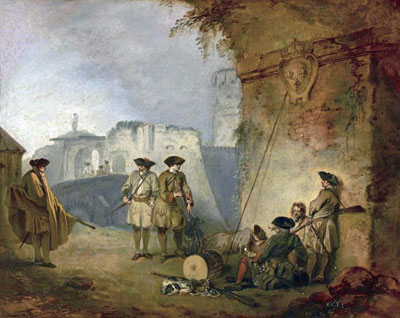 o Watteau's Soldiers: Scenes of Military Life in Eighteenth-Century France is a surprise for those who think of the artist only as a painter of elegantly garbed men and women in bucolic settings. The art in this exhibit did not focus on battles but rather the everyday life of the common soldier. Only seven of such paintings survive, and four are in this show along with a dozen of his studies in chalk and some works by his predecessors and followers. Until October 2 at New York City's The Frick Collectioin. More information available at www.frick.org. o Hubert Robert was one of the first curators at the Louvre in Paris. He was a prolific painter of architectural subjects such as the ruins he found in Italy, urban renewal projects in France and Gallo-Roman antiquities. At an exhibit entitled Hubert Robert, 1733-1808 works depicting his fascination with architecture are on display. He was also interested in drafting, printmaking, interior design and garden design. The show peresents 100 of his paintings and drawings through October 2 and the National Gallery of Art in Washington DC. Information at www.nga.gov. PROVENCE ART EXHIBITS
courtesy of
Anita Rieu-Sicart and the Var
Village Voice
Musée de l'Annonciade,
Saint-Tropez - June 18 to October 17Traveling to Provence between now and October? If so, you will have the opportunity to see the works of three very special artists ~ one exhibit is in lovely Saint-Tropez, a place worth visiting at any time, and the other two in bustling Aix-en-Provence, a cultural center with numerous expositions, theatre, musical events and art.
Othon
Friesz – Une Fauve singulier
Despite some
success in his lifetime, Othon Friesz (1879-1949) is now a little-known
artist. And this is the first exhibition to date to be devoted to
his Fauve period. It's a bold gamble considering that this period
did not last more than two years (1906-1907). However, the
rigorous analysis of the work of tawny Friesz demonstrates that, far
from being a minor or marginal player, the latter, once engaged, fully
participated in Fauvism bringing a unique contribution to the movement
that now deserves to be recognized. 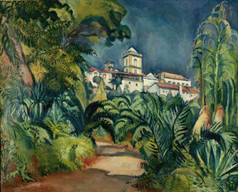 Although most of the exhibition analyzes his Fauve period, it also hopes to show the path that led from that, and, following this period, explain the radical change in his painting to a traditionalist trend. The first
works presented are those of his initial training during which,
refusing
academic teaching, he was influenced by Impressionism, particularly
through Guillaumin and Pissarro. This was followed by the first
wild
tests during his stay in Antwerp in the summer of 1906, then in
Honfleur where he began his Fauve period. Confronted by nature,
that of the country of the Côte de Grace, Friesz found the
inspiration to make the leap to the authentic Fauvism, full of
expression. In La Ciotat in the summer of 1907, by then so
familiar to Fauvists, it came to its climax.
Turner et la Couleur
Other works have been loaned by the
London Royal Academy, the Oxford Ashmolean Museum, and the Musée
d'Art
of Dallas. This exhibition, from the credits alone, promises to
be a blockbuster, certainly for Turner fans, and a chance to see so
many
of his works in one place.
Works on exhibit include Lowther
Castle, Lincoln Cathedral, Going to the Ball, Landscape with Water,
Chichester Canal, Frosty Morning, the Scarlet Sunset plus others.
Perhaps, as well, many works that might have figured in the
recent film starring Timothy Spall.
In addition to paintings, other
forms of art flourish. One can view a film devoted to
Cézanne
and the town of Aix. There are concerts, artistic performances,
forums and lectures. The rooms have been magnificently restored,
and there is now a shop/boutique/library, together with a lovely
café/restaurant overlooking a wonderful terrace, gardens, a
courtyard
and a French box parterre
~ a formal garden. The
lower
garden is stunning with a typically Provençal fountain against
the far
wall, lines of tailored trees, and huge pots of flowers.
Hôtel du Caumont Centre d'
Art,
3 rue Joseph Cabasse, 13100 Aix-en-Provence. Telephone:
04.42.20.70.01
Musée Granet, Aix-en-Provence
- Until October 2
Camoin dans sa Lumière
There is a stunning
new show devoted to Camoin and his artist friends, Manguin,
Cézanne,
Marquet and Matisse. The Granet collaborated two years ago with a
museum in Marseille on the outstanding two-part exhibition Grand Atelier du Midi devoted
to impressionist artists of the region as part of the huge Marseille
Culture Capital events of 2013. And, if that show was anything to
go by, this one will be as equally presented and wonderfully
curated. Definitely not to be missed. Charles Camoin was born in 1879 in
industrial-era Marseille, a city at that time mainly turned towards the
French colonial empire. Camoin belongs to a generation of artists
living at the turn of the century in a time of sweeping technical,
philosophical and artistic changes. He was very close to Matisse,
Manguin and Marquet, whom he met at the Beaux-Arts in Paris.
Camoin is associated with the Fauves and is the only Fauvist painter
who
had close links with Cézanne. It is said that Camoin was
the
most Cézanne-like of the Fauvist painters. We still have a
large
collection of letters exchanged by the two men. As Matisse said
later, "I learned a lot of things (about Cézanne) through Camoin
.
. ." Contrary
to Cézanne, Charles Camoin was an artist whose work became
rapidly known
in Europe, especially in Germany where it came to the attention of
avant-garde painters such as Macke and Kirchner. From 1907, his
paintings were shown and discussed in modern art exhibitions in Berlin,
Frankfurt, Cologne and Munich, and the letters he received from
Cézanne
were translated for the German-speaking press. 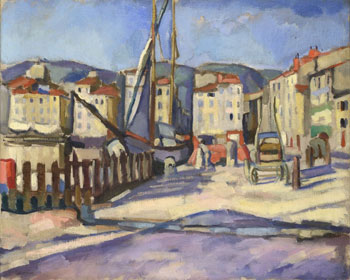 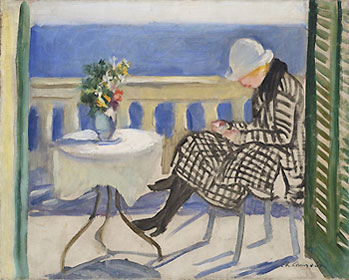 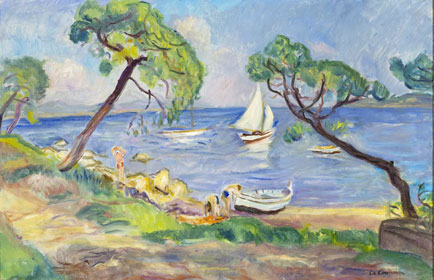 Charles Camoin: Port de Cassis 1905, Lola sur la Balcon 1920, and Voilier Blanc dans la Baie des Canoubiers 1939 Featuring more than 60 works by these artists, some of which will be on show for the first time, the works are distributed in over more than 700 square meters of exhibition space. It is worth noting how interest in both Camoin and Manguin has risen in the past few years ~ minor neo-Impressionists and primarily Fauvists, they now attract far more attention than ever before. Musée Granet, 18 rue Roux Alpheran, Place Saint-Jean de Malte, Aix-en-Provence. Telephone: 04.42.52.88.32 http://www.museegranet-aixenprovence.fr Tickets €7; closed Mondays. Subscribe today to
the Var Village Voice, Provence's most informative and interesting
English-language newsletter.
Visit Anita's web site at http://www.varvillagevoice.com
|
 previous
page
next page
previous
page
next page  |